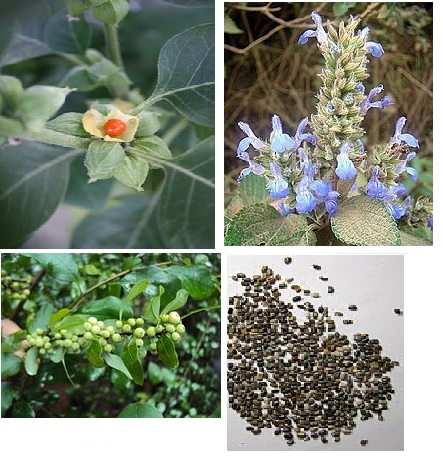How This Helps
Ayurvedic treatment for Hypothyroidism involves an integrative approach. There are many herbs known in Ayurvedic text for their healing benefits for Hypothyroid symtpoms:
1. Ashwgandha helps to rejuvenate the adrenal gland and stimulates the thyroid gland. It is an adaptogenic herb that helps to balance the thyroid levels in the body
2. Guggul supplements can help to regulate the function of thyroid since it helps to convert the thyroid hormone T4 in to T3. T3 is more active and so, it helps to burn more fat and increase the metabolism of the body.
3. Chia seeds can help in both hypo and hyper thyroid disorders. They can help to speed up the functioning of a thyroid that is not performing optimally and it can also calm down an overactive thyroid.
4. Maca root helps to stimulate the thyroid gland which in turn helps to increase the production of thyroid hormone.
Instructions
Herbs for hypothyroidism
Hypothyroidism –
The thyroid gland performs a vital function: It produces the hormones that regulate the body’s metabolism and keep them in balance. Thyroid hormones direct many of the body’s processes. Symptoms include weight gain, constipation, dry skin, and sensitivity to the cold.
Ashwagandha-Withania somnifera
The traditional use is as a powder, mixed with warm milk and honey, and taken before bed. The dried leaves are ground to a powder from which a paste is made and used in the treatment of burns and wounds. The berries and leaves are applied externally to tumours, tubercular glands, carbuncles and ulcers. Ashwagandha helps to balance hormones in Hypothyroidism. Ashwagandha can be considered for treatment of sub-clinical hypothyroidism in mood disorders.
Guggul (Commiphora mukul)
Guggul has beenused for centuries in Ayurveda to treat internal tumors, obesity, liver disorders, malignant sores and ulcers, urinary complaints, intestinal worms, leucoderma (vitiligo), sinuses, edema and sudden paralytic seizures. It has been used to treat various diseases including hyper-cholesterolemia, atherosclerosis, rheumatism, and obesity over several thousands of years. Guggul is also helpful for patients with hypothyroidism.
See: Ayurvedic Remedies To Boost Immunity
Salvia hispanica

It is commonly known as Chia seeds. It is a rich source of the B vitamins, thiamine, and niacin, dietary minerals calcium, iron, magnesium, zinc, phosphorus andmanganese. Chia seeds can be added to other foods as a topping or added to yogurt, smoothies, energy bars, breakfast cereals, granola bars, tortillas and even breads. It is used to prepare a sharbat (cold beverage). Chia seeds curb hunger and lower the appetite as it helps in losing weight.
.
Maca (Lepidium meyenii)
The root also can be mashed and boiled to produce a sweet, thick liquid, then dried and mixed with milk to form a porridge. The cooked roots are also used with other vegetables in empanadas, jams, or soups. The root may be ground to produce a flour for bread, cakes, or pancakes. It contains significant amounts of natural iodine; a 10-gram serving of dried maca generally contains 52 µg of iodine.
See: Hypothyroidism Natural Treatment Ayurveda
.
< p>
References
1.http://www.ncbi.nlm.nih.gov/pubmedhealth/PMHT0022776
2.http://www.ncbi.nlm.nih.gov/pubmed/19189646
3.http://www.ncbi.nlm.nih.gov/pubmed/18078436
4.https://en.wikipedia.org/wiki/Withania_somnifera
5.https://en.wikipedia.org/wiki/Salvia_hispanica








